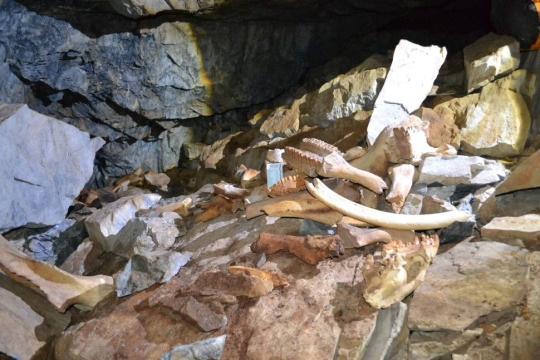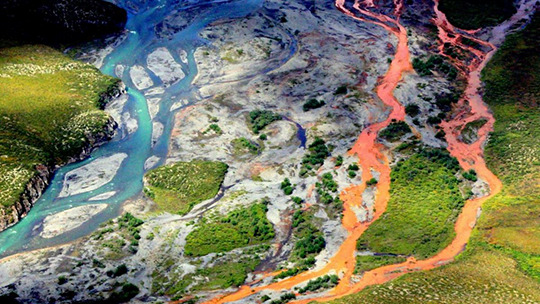#LiveScience
Explore tagged Tumblr posts
Text
89 notes
·
View notes
Text
My newest article for LiveScience is about a ton of Pleistocene bones found in a cave in Siberia!
We're talking:
Mammoths
Horses
Wooly Rhinos
Wooly Bison
Brown Bears
Wolves
Yaks
Deer
Gazelles
Rodents
Birds
Fish
Frogs
and of course, cave hyenas! Including baby ones!
All the bones are chewed up too

(Image credit: V. S. Sobolev Institute of Geology and Mineralogy)
236 notes
·
View notes
Photo

‘Gigantic jet’ that shot into space may be the most powerful lightning bolt ever detected.
#night#night time#electricity#lightning#lightning bolt#lightning bolts#gigantic jet#gigantic jets#sky#space#atmosphere#livescience#article#articles#nature#natural phenomena
12 notes
·
View notes
Text

Finally we can say that Netflix will work with oda on 6 more seasons on one piece Netflix .. great news tho
15 notes
·
View notes
Text
Author & Timestamp: Jennifer Nalewicki for LiveScience.com, published April 25, 2024
Note: the headline is ever so slightly misleading, though in the same way that most news headlines written for the general public tend to be.
Extract:

(Image credit: Italian National Research Council)
The decipherment of an ancient scroll has revealed where the Greek philosopher Plato is buried, Italian researchers suggest.
Graziano Ranocchia, a philosopher at the University of Pisa, and colleagues used artificial intelligence (AI) to decipher text preserved on charred pieces of papyrus recovered in Herculaneum, an ancient Roman town located near Pompeii [...].
[...]
One of the scrolls carbonized by the eruption includes the writings of Philodemus of Gadara (lived circa 110 to 30 B.C.), an Epicurean philosopher who studied in Athens and later lived in Italy. This text, known as the "History of the Academy," details the academy that Plato founded in the fourth century B.C. and gives details about Plato's life, including his burial place.
Historians already knew that Plato [...] was buried at the Academy, which the Roman general Sulla destroyed in 86 B.C. But researchers weren't sure exactly where on the school's grounds that Plato, who died in Athens in 348 or 347 B.C., had been laid to rest.
[The application of] techniques including infrared and ultraviolet optical imaging, thermal imaging and tomography [have allowed researchers] to read the ancient papyrus, which is now part of the collection at the National Library of Naples.
So far, researchers have identified 1,000 words, or roughly 30% of the text written by Philodemus.
"[...] we read that Plato was buried in the garden reserved for him (a private area intended for the Platonic school) of the Academy in Athens, near the so-called Museion or sacellum sacred to the Muses," researchers wrote in the statement. "Until now it was only known that he was buried generically in the Academy."
The text also detailed how Plato was "sold into slavery" sometime between 404 and 399 B.C. (It was previously thought that this occurred in 387 B.C.)
/end of extract
#headline clickbait rating: 1.5 out of 5#LiveScience#ancient scroll#Plato#papyrus#Herculaneum#Philodemus of Gadara#History of the Academy#4th century B.C.E#ancient papyrus#Philodemus#translated text#classical studies#history#archaeology#antiquity#archaeological discoveries#classical antiquity#ancient rome#classics#archaeological news
2 notes
·
View notes
Text

Andrew Ostrovsky | LiveScience
4 notes
·
View notes
Text
ID: A screenshot of an article from LiveScience titled: "1st preserved dinosaur butthole is 'perfect' and 'unique,' paleontologist says", written by Laura Geggel and dated January 19, 2021.
Below is a subtitle reading: "This was a multipurpose hole."
End ID.

first class news paleontologists never disappoint
26K notes
·
View notes
Text
Perhaps this is why Lucifer loves ducks so much: they’re survivors, just like him and Lilith.
Vegavis: a small bird that managed to survive the disaster that wiped out the likes of Tyrannosaurus rex; and whose descendants now fly, walk, and swim all over the world.
Lucifer and Lilith: cast out of paradise; only to turn their prison into a home, and then a kingdom. Adam, the angel who slaughtered their subjects, now dead and defeated at the hands of the demons he despised.
1 note
·
View note
Text
1 note
·
View note
Text
7 notes
·
View notes
Text
from LIVESCIENCE ... 3/22/24... "SPERM WHALES DROP GIANT POOP BOMBS TO SAVE THEMSELVES FROM ORCA ATTACK"
by Jennifer Nalewicki "Sperm whales blasted a "big dark bubble" of poop to prevent an impending orca attack off the southern coast of Western Australia. Scientists witnessed the clever defense strategy unfold Tuesday (March 19) during a tourist excursion in Bremer Canyon, a whale-watching hotspot off the coast between Albany and Hopetoun. They described seeing a "cloud of diarrhea" permeate the water, and this rarely seen defense mechanism seemed to help the sperm whale pod escape what could have been a fatal attack by at least 30 killer whales, ABC News Australia reported. "It's called defense defecation," Jennah Tucker, a marine biologist with Oceans Blueprint, a marine and environmental sciences research organization, who was on the charter boat, told ABC. When the animals defecate, she said, they pass their huge tails through their poop to drive away or confuse attackers. As the event unfolded, onlookers noticed a large, "dark bubble" pop up to the water's surface. At first, they thought it was blood from one of the sperm whales, potentially a small calf. But when the team later reviewed footage of the plume, they realized it was actually whale poop. "Because [a] sperm whale's diet consists mostly of squid, they actually have this really reddish colored poo," she said."
Source: livescience.com
5 notes
·
View notes
Text
so is livescience just
completely unreliable garbage where the writers just make crap up for clickbait
run with very low standards and editors who don't check any of the articles for blatant misinformation
or "was really bad ages ago and is now better but they just haven't bothered to retract/delete the old garbage articles for over a decade"
#I'm sure this is something I should already know but in my defense I've only read maybe three livescience articles#and two of them might be me misremembering articles I read on another site ages ago as being from livescience#so my only reference for their credibility is the article where the writer claims medieval plate leg harness was *8 kilograms per leg*#and the total weight of a field armour was fifty entire kilograms#which I just read
0 notes
Text
Not everyone agrees on these findings:
The study concludes that the world started warming roughly 80 years before the IPCC’s estimates, and that we already surpassed 1.7 degrees Celsius in 2020. That’s a big “woah, if true” moment, but some scientists are skeptical. One such scientist, speaking with LiveScience, said that “it begs credulity to claim that the instrumental record is wrong based on paleosponges from one region of the world … It honestly doesn’t make any sense to me.” Other experts expressed wanting to see more data before completely upending the IPCC’s climate goalposts, which say the Earth is currently hovering at a long-term temperature change of around 1.2 degrees Celsius.
But regardless of whether or not we passed the threshold...
Unfortunately, even if the sponges are wrong, there’s mounting evidence that we are in the process of crossing that 1.5 degree threshold as we speak. This January was the hottest on record, clocking in at 1.7 degrees above pre-industrial temperatures. According to New Scientist, that means we’ve been above 1.5 degrees of change for at least a year. That doesn’t jump the long-term average over the 1.5-line, but it’s certainly a sign we’re getting close fast.
326 notes
·
View notes
Note
I saw the tuna post. Genuine inquiry: can you please share some of your favorite tuna facts?
Gladly! I already shared some of my favourites, but I can describe them in further detail.
There are 15 species in the Thunnini tribe (the tunas), split between five genera. Most tunas, eight species, are in the genus Thunnus, which is also called “true tunas”! The biggest of them all, Atlantic bluefin tuna, has been reported to reach a maximum size of 4.6 m/15 feet and 900 kg/~2 000 lbs. Read that again. Really take it in. The largest tuna ever measured and weighed were longer than two Shaquille O’Neals stacked on top of one another, and weighed over six Shaquille O’Neals! (I hear people like hearing measurements in Shaquille O'Neals.)
Naturally tuna don't always reach such gargantuan sizes, the average Atlantic and Pacific bluefins are around the two meter/~6.5 feet length range. The average southern bluefin, yellowfin, bigeye tuna and albacore are all around one to two meters long (~3 feet to ~6.5 feet), and one of the more common tuna species to be eaten (especially canned), skipjack tuna, is 80 cm/31 inches long on average. Still, that's not tiny! It's twice as big as your average largemouth bass or pike.
Like I described in my original tuna post, everything about tunas is evolved for speed. Their lunate tail has little surface area to minimise drag in the water. Near their tail they have stabilising horizontal keels. Their dorsal fin has a special groove in the body where it can be tucked completely hidden. Tunas can also tuck in their pelvic fins when they swim at great speeds, less fins sticking out meaning more hydrodynamic shape! Of course though, fins are great for controlling where you're swimming and when you're doing sharp turns: to keep their turns as hard as possible, it has been found that (at least Pacific bluefin and yellowfin) tunas actually use their lymphatic system to pump their dorsal and anal fins full of fluid! The fluid forces the fins into an erect and extremely stiff position that gives the tunas plenty support to stop in their tracks in the water and turn around. A wonderful LiveScience article says it best, making turns with stiff fins versus floppy fins is like "the difference between trying to turn a canoe with a pool noodle versus a sturdy wooden oar."
Tunas have red flesh unlike the white flesh of most fish, and that's because they're simply jam packed full of myoglobin. Swimming continuously and especially swimming at lightning speeds for even a small amount of time takes up a lot of oxygen, and the tuna's blood can bind a lot of it! Also, most interestingly, the circulation system of tunas is set up in such a way that heat produced from their metabolism is retained to heat the body in what is called countercurrent heat exchange. I'll explain this in a lengthier way.
Usually, when blood travels to the peripheries of a fish's body -- even if it was warmed by the fish's metabolic processes -- tends to cool down as it moves closer and closer to the outside world, i.e. the water surrounding the fish. When the blood travels back to the heart and the organs, it's still that cool temperature, for a fish do not keep a constant consistent body temperature like mammals or birds can. This is made no better with the gills, as they are in constant contact with water and the blood of a fish is therefore also constantly in contact with the cooling forces of the water. However! The way that tunas do it is that as the blood vessels travelling further away from the heart are subjected more and more to the cooling forces of the outside world, they are closely intertwined with blood vessels that are going from the periphery back into the center of the body. What happens then is that as the cool blood comes back into the body, it is essentially surrounded by blood that is warmer and warmer the deeper inside it goes. This transfers the heat to the blood vessels that go inside the body, warming the blood overall and allowing tunas to keep their body temperature significantly higher than the surrounding environment! Here's a picture that shows how that works. Fun fact: the net of veins that warms the tuna is called a rete mirabile, a "wonderful net".

Tunas use this tactic to warm their swimming muscles, their brains and their eyes: tunas are visual predators that need to see well, efficiently process what they see, have quick reaction times and fast reflexes, and of course, swim extremely fast. It works rather well for them, as they can maintain a body temperature several degrees higher than the surrounding water!
All these things combined make tunas a fierce oceanic predator! The yellowfin tuna is the fastest and can reportedly swim at a top speed of 75 km/h or 47 mph, but the others aren't bad either, the Atlantic bluefin can swim with a max speed of 53 km/h or 33 mph for example! Estimates for speeds vary a lot though, some max speeds are easily overestimated if there’s no way to accurately measure speed. For one, the NOAA Fisheries site claims that the albacore tuna can reach speeds of over 80 km/h or 50 mph, but then clearly they would be the fastest tunas, even though it’s often agreed that title goes to the yellowfin….? Mmm… Just, they’re fast. They’re very really fast.
Tunas like to swim in schools, sometimes comprised of multiple tuna species. All together they are the terror of fish schools in the temperate and warm seas of the world >:) They tend to stick to surface waters, but some tunas can dive even up to a kilometer deep (3 280 feet), namely Atlantic bluefins! Many species make great migrations between their breeding grounds and where their food goes, they can swim kilometers upon kilometers nonstop without ever tiring. "Nonstop" isn't even hyperbole in this case by the way, tuna cannot stop swimming as their oxygen intake relies on ram ventilation similar to some species of sharks. If they stop, they cannot get water on their gills and suffocate as a result. It's not really known if and how tunas rest as a result, because they are always on the go. Also I don't really know where else to say this, but the keels of tunas actually have a lateral line canal that differs from the rest of the body's lateral line, which might help tunas sense things like water flow and pressure near the tail. The more you know!
I can't leave these facts here without showing some proper tuna pictures that showcase their size. Here’s a 191 kg/422 lb Atlantic bluefin tuna!

Sadly out of the water, but... look at that. Tiger of the ocean, that is.
#tuna#bluefin tuna#atlantic bluefin tuna#pacific bluefin tuna#yellowfin tuna#bigeye tuna#albacore#skipjack tuna#skipjack#southern bluefin tuna#tunafish#fish facts#fishfact#asks#mushroommanchanterelle#fish
80 notes
·
View notes
Text
Melting Permafrost Stains Alaskan Rivers Orange

The swiftly melting permafrost of the Arctic is releasing toxic metals like zinc, cadmium, and iron into Alaskan waterways. The contaminant levels are so high that it's staining many rivers orange -- a feature that can be seen from space. (Image credit: K. Hill/National Park Service; research credit: J. O'Donnell et al.; via LiveScience; submitted by Emily R.) Read the full article
163 notes
·
View notes
Text
Animal of the Day!
European Hamster (Cricetus cricetus)

(Photo from LiveScience)
Conservation Status- Critically Endangered
Habitat- Western Europe, Russia
Size (Weight/Length)- 300 g; 25 cm
Diet- Cultivated vegetables; Fruits; Grasses; Seeds; Nuts; Small animals; Insects
Cool Facts- Despite being absolutely adorable, the European hamster is no pet. Roughly the size of a guinea pig, these hamsters are highly aggressive to fight off rival hamsters and predators as large as ferrets. European hamsters spend their days sleeping and their nights foraging. Unfortunately, these hamsters are critically endangered due to poaching for their fur, habitat destruction, and persecution by people who believe them to be agricultural pests. Captive breeding programs throughout Europe are working to increase the wild population of these delightful furballs.
Rating- 12/10 (Can carry 20% of their body weight in their cheeks)
#animal of the day#animals#rodents#hamster#tuesday#august 29#european hamster#biology#science#conservation#the more you know
463 notes
·
View notes